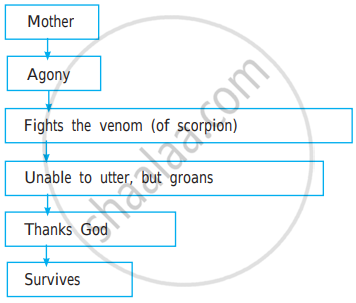Advertisements
Advertisements
Question
Expand the flow-chart in writing a paragraph in your own words.

Solution
The poet's mother is bitten by a scorpion and is in great agony. She fights the venom of the scorpion with the help of her husband and the villagers. She is unable to say anything, but only groans in pain. Finally, the poison is tamed after twenty hours. In the end, the mother thanks God that she has survived the ordeal, and that the scorpion had picked on her and spared her children.
APPEARS IN
RELATED QUESTIONS
Read the following extract and do the activities.
I remember the night my mother
was stung by a scorpion. Ten hours
of steady rain had driven him
to crawl beneath a sack of rice.
Patting with his poison – flash
Of diabolic tail in the dark room -
he risked the rain again.
The peasants came like swarms of flies
And buzzed the name of God a hundred times
to paralyse the Evil One.
With candles and with lanterns
throwing giant scorpion shadows
on the mud-baked walls
they searched for him: he was not found.
They clicked their tongues.
With every movement that the scorpion made his poison
moved in Mother’s blood, they said.
(A1) Choose the correct option for the following.
(1) The incident in the poem took place in
(i) the morning (ii) the night
(iii) the afternoon (iv) the evening
(2) ‘The Evil’ mentioned in the poem was
(i) the peasant (ii) the God
(iii) the scorpion (iv) the mother
(3) The scorpion crawled beneath a sack of
(i) sugar (ii) a wheat
(iii) corns (iv) rice
(4) The peasants are compared with
(i) flock of sheep (ii) group of monkeys
(iii) swarms of flies (iv) herds of cattle
(A2) Write the reactions of the people when they knew that the mother was stung by a scorpion.
(i)..................................................................
(ii)................................................................
(iii)...............................................................
(iv)...............................................................
(A3) Write down the rhyming words from the stanzas for the following.
(i) fight - (ii) clash -
Get into pairs and discuss the following with your partners and complete the table.
Many people are superstitious. This means that they have a belief for which they have no logical reason.
An example of superstition is that - walking under a ladder brings bad luck. In pairs, list any superstitions that you know of.
| Superstition | What it implies |
| (1) Smashing a mirror | Brings seven years of bad luck. |
| (2) | |
| (3) | |
| (4) | |
| (5) |
Complete the following table.
| Background/setting of the poem | |
| Type |
Evidence (Quote lines from the poem |
| Rural/Urban | ______________________ |
Complete the following table.
| Scorpion | |
| Many images of the scorpion contrast in the opening lines of the poem. Find examples of each and add them to the columns below. | |
| Timid | Dangerous |
|
(1) hides _________ (2) ___________ back |
(i) Diabolic ____________ (ii) ____________ |
Complete the following table.
|
Imagery |
|
| Look at the description of the village peasants. What does the imagery suggest about them? |
|
| The Images | What images suggest |
| They came like swarms of flies. | |
| They buzzed the name of God. | |
| They threw giant scorpion shadows on the mud-baked walls. | |
| They clicked their tongues. | |
Choose the correct alternative.
The poet seems to see the villagers as impractical and almost irritating which suggests that ________________.
Choose the correct alternative.
This is a _____________ poem as it tells a story.
Choose the correct alternative.
The peasants chant the name of God to _______________.
From the poem provide evidence for the following:
| Stages | Evidence (lines from the poem) |
| (a) the attempts by the peasants to help alleviate the mother’s pain. | |
| (b) the action of these same peasants to kill the scorpion | |
| (c) the reaction of the rational father. | |
| (d) the various superstitions versus the ‘scientific’ | |
| (e) evil versus good. |
Read the following poem and write an appreciation of it with the help of the given points in a paragraph format:
|
Night of the Scorpion I remember the night my mother |
Points:
- The title and the poet of the poem
- Rhyme scheme
- Figures of speech
- Central Idea/Theme
